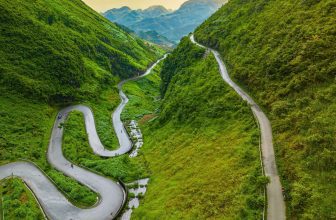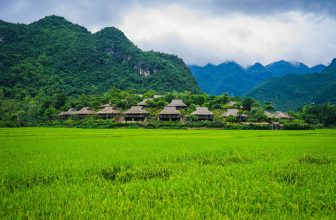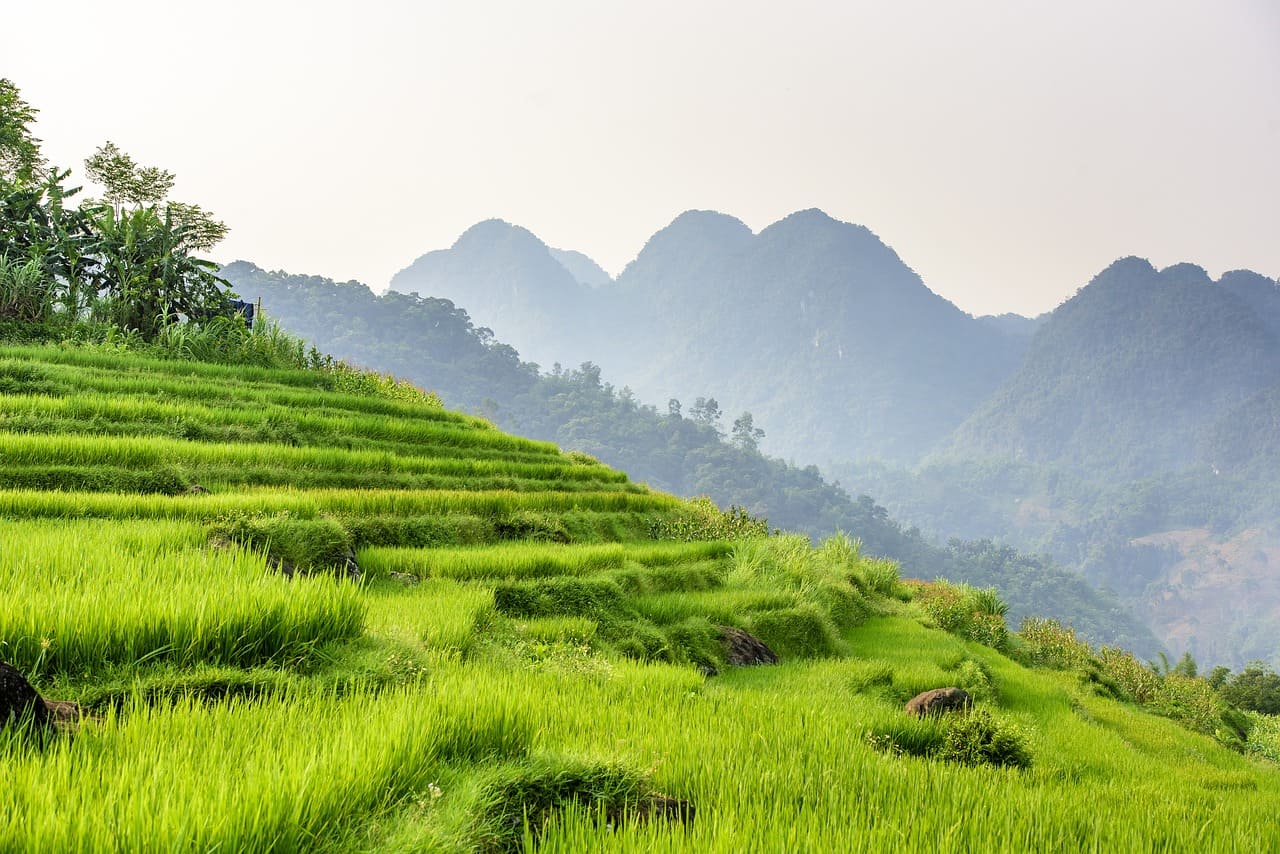
Overview of Pu Luong Nature Reserve
You wake up, stretch, and look out your window bam! Lush terraced rice fields ripple away beneath misty hills. If you have not tried doing yoga on a bamboo floor while villagers herd water buffalo down a foggy path well Pu Luong is calling your name.
Let’s talk location for a sec. Pu Luong Nature Reserve lounges in Northern Vietnam, about 160 km from Hanoi (yep, it’s close enough for a long weekend that actually feels long). At around 1,700 meters above sea level, you get that crisp mountain air that makes your lungs do a happy dance. Honestly, if you have slogged through a Hanoi summer, you’ll practically feel reborn up here.
Sweaty city people: this place was made for you.
What Makes Pu Luong a Magnet for Adventurers?
Alright, you want adventure? Pu Luong’s got you:
- Diverse Scenery: Rice Terraces so bright green you’ll wonder if someone cranked up the saturation slider, primal bamboo forests where the only traffic jam is a pile up of butterflies, brooding limestone peaks that could make even your most cynical friend say “wow”.
- Trekking & Hiking for All Levels: Whether you want a sweat dripping climb up Pu Luong Peak or just an easy stroll through Lan Village, there are routes that fit every mood (even “I’m mainly here for photos” days).
- Cultural Encounters (No Awkward Group Dances Required): Pu Luong is home to ethnic Thai and Muong communities. Think traditional stilt houses, woven textiles, rice wine that will sneak up on you, plus nightly dance performances… if you dare to join in.
Quick Reality Check
Worried about getting lost? Most trekking routes are locally marked, but you can always book a guide if your sense of direction is, uh, “creative” (raises hand). Cell signal is surprisingly decent even if you claim you’re “off grid” on Instagram.
|
Area |
Elevation (m) |
Distance from Hanoi (km) |
Main Activities |
|
Pu Luong |
up to 1,700 |
160 |
Trekking, hiking, ecotourism |
|
Nature Reserve Size |
17,600 ha |
– |
Nature walks, photography |
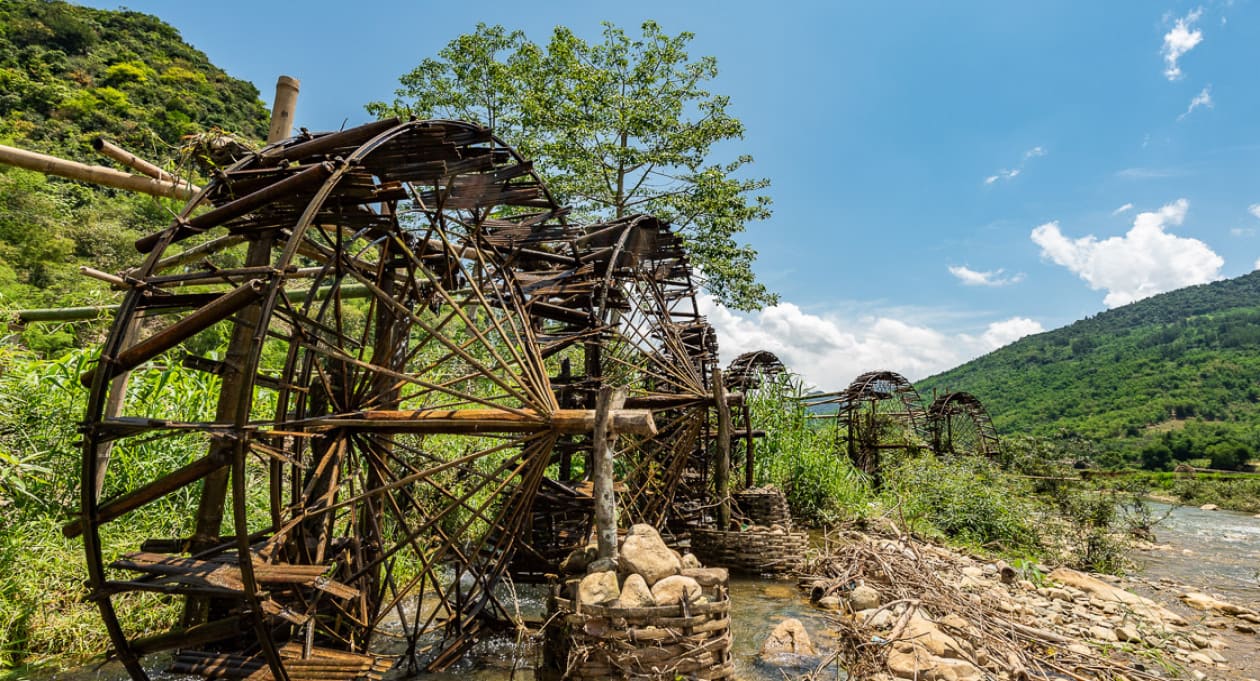
Pu Luong Nature Reserve Lover
What’s Actually Unique?
Here’s a confession: my first trek here, I slipped face first into a rice paddy. Embarrassing yes. Worth it? Absolutely. Anyone who loves pure, wild landscapes (or Insta bragging rights) will appreciate Pu Luong. Unlike the over snapped Sapa, Pu Luong still feels delightfully “undiscovered”. No crowds. No tacky souvenir shacks at every bend.
You might spot water wheels clacking away on streams, or villagers in conical hats tending the terraces actual life, not a theme park setup. Cultural details shine too. If you time your adventure right (hint: go either in late May or September when rice is green or gold) you will see landscapes that practically beg to be made into desktop wallpapers.
For Beginners (and Skeptics)
Never trekked before? Start with the village to village routes. Kho Muong Village is a gentle intro, and you can reward yourself afterward with a hearty bowl of sticky rice (the kind that sticks to your insides, in a good way). Just bring shoes you do not mind getting muddy. Or take it slow, pause often for, ahem, scenic photography (not catching your breath…).
Pro tip: If you forget something basic (raincoat, mosquito repellent, snacks the kids will actually eat) small local shops at villages often save the day. Yes, they even have instant noodles and cold cans of Sprite.
If you’re daydreaming about sunrise panoramas, birdsong, and cultural detours that do not feel staged well, Pu Luong Nature Reserve trekking kind of nails it. And don’t worry. If your idea of roughing it is a cold shower and no Wi Fi, there are cozy ecolodges waiting, too.
Ready for the details on the best trekking routes? Let’s lace up and dive in…
Trekking Trails Available in Pu Luong Nature Reserve
So you’re considering pu luong nature reserve trekking but wondering where to start? Good news there are plenty of trails, from easy strolls to “whoa, my calves are burning” routes. Trust me, even if your idea of adventure usually means choosing a new Netflix series, Pu Luong does a great job meeting you at your comfort (or discomfort) level.
Easy Trekking Routes in Pu Luong Nature Reserve
Beginner? Not sure if you’ll survive more than a couple hours without a boba tea break? Totally fine. These trails offer what I call “softcore adventure” just enough scenery to make your Instagram pop, but not enough mud for anyone to lose a shoe. Plus, you still get all the best bits: bamboo groves, rice terraces, and streams you can skip across like a barefoot local kid (though proper sneakers help).
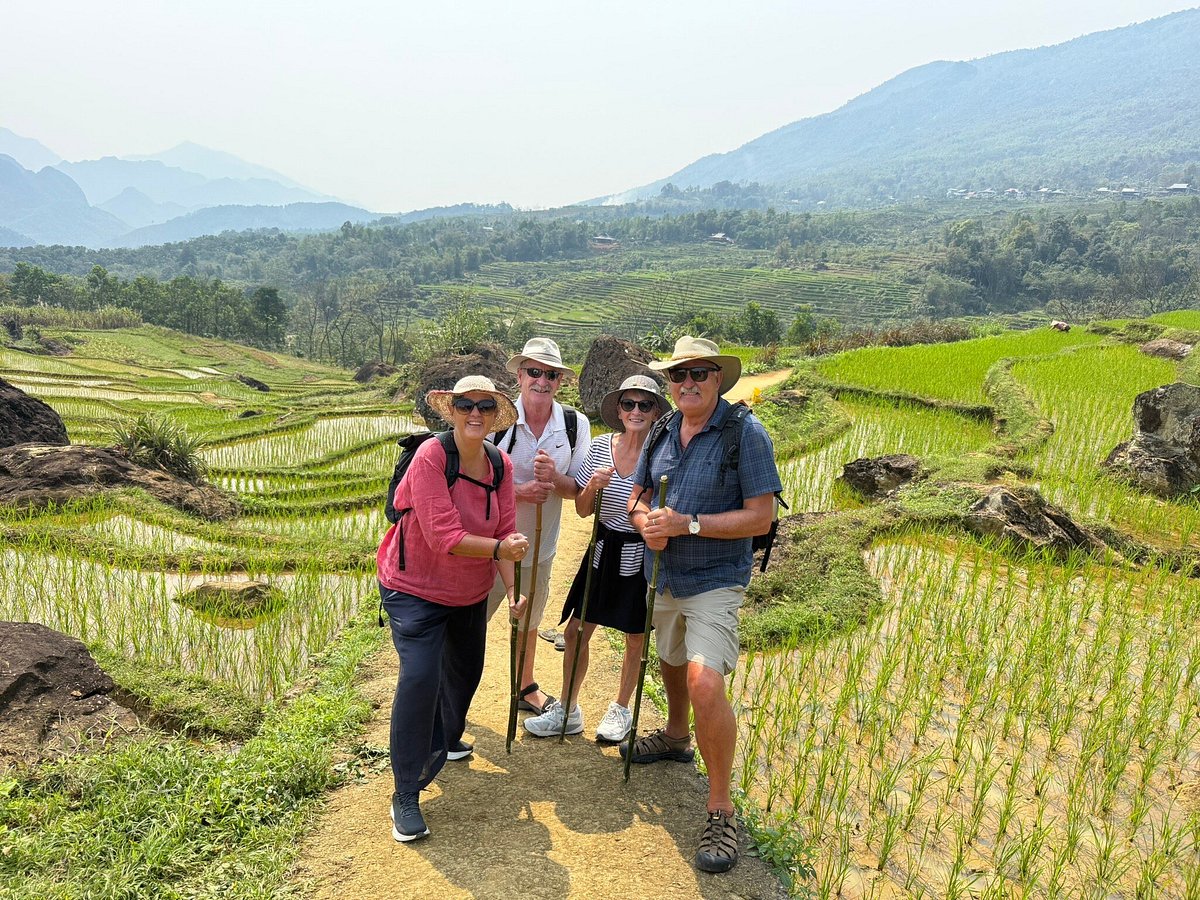
Trekking Trails Available in Pu Luong Nature Reserve
Route 1: Trek from Bang Village to Kho Muong Village
Ever wanted to wander through storybook Vietnam think mist floating on golden rice fields, water buffalo looking at you like, “Seriously, what are you doing here?” this is it. The stroll from Bang to Kho Muong is basically a highlight reel of rural life. You’ll cross wobbly bamboo bridges and pass by stilt houses that look straight out of a travel magazine.
If you’re a fan of brands like The North Face, this route is easy enough you can leave the technical hiking boots at home simple trail shoes do the trick. Locals often wander this path in $4 sandals and outspeed most city folks, so don’t stress about gear. Bring some small bills: the kids selling sticky rice snacks are absolute MVPs.
Anecdote time: Last time I trekked here, a family invited us in for tea no touristy upsell, just home brewed hospitality (and, uh, rice liquor that would floor a sumo wrestler). Pu Luong’s warmth goes beyond the weather.
Route 2: Trek from Don Village to Lan Village
Who doesn’t love a route that mixes adventure with authenticity? The walk from Don to Lan Village is my personal go to for a low stress but “I feel accomplished!” experience. Sure, you’ll climb a few hills cue the fake panting and “Is it lunchtime yet?” jokes but honestly? The views of terraced rice paddies are worth every drop of sweat.
This trail passes through winding forest paths and occasionally gets muddy (especially after summer rains), but nothing you can’t handle with a pair of waterproof Merrells or even your trusty Nike runners. Let’s be honest: if I can do it after skipping breakfast, so can you.
You’ll pass women weaving baskets, men herding ducks, and probably a grandma giggling at your sunburned face. Kids may ask for a game of hacky sack warning: they have skills. There are actual side trails, but stick to the main one if you want to avoid “Where’s my GPS?” moments.
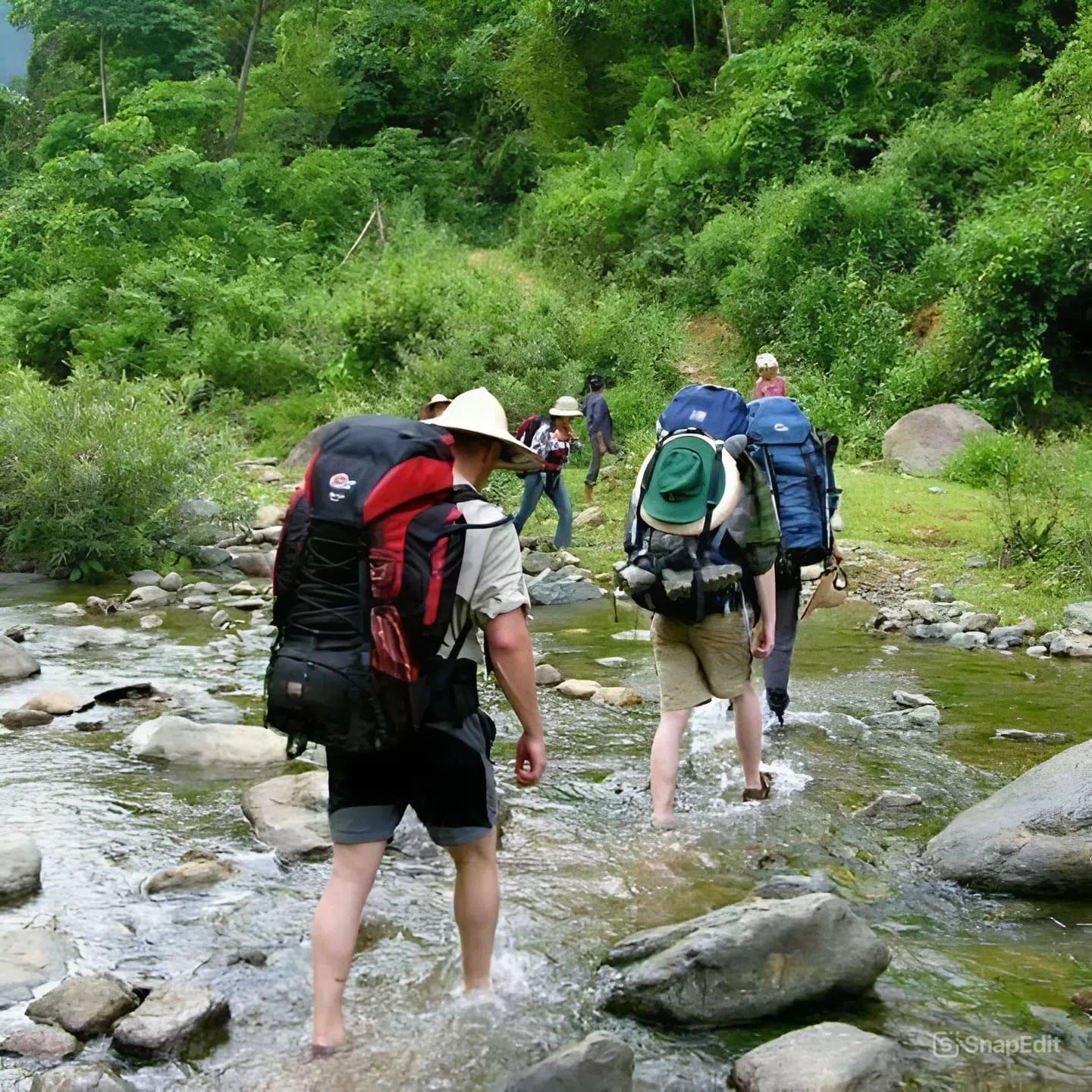
Route 3: Trek from Ban Cong Village to Bamboo Raft Area
Ready for a curveball? This isn’t just any stroll. The path from Ban Cong to the bamboo raft dock feels like a gentle “choose your own adventure” novel. The route winds along a sleepy river and through forest patches, and ends with you guessed it a bamboo raft crossing. (Bring a GoPro you’ll thank me.)
Sometimes you’ll spot folks bringing supplies on Honda Waves or pushing a wheelbarrow with a piglet riding shotgun. The trail is mostly flat, so you won’t be gasping for air, but if you have a Fitbit, expect to smash your steps goal. Fishermen will offer you fresh river snails for 20,000 VND a handful (roughly $1 USD) (not everyone’s thing, but it’s a flex for your social media).
If things go sideways and you get lost (it happens, no shame) locals are quick to help and may even walk you back … while chatting away in a vivid mix of Vietnamese and hand gestures. The beauty here is that even when you’re “off trail,” you’re right in the heart of authentic Vietnam. Not bad for a $1.50 bus ride from the main road.
Sometimes the best part of Pu Luong isn’t the striking peaks or valleys but these easy trails that let you slow down, meet real people, and assuming you’re like me sneak in a snack break or two. Looking for more of a challenge, or want an adventure tale for your next family gathering? Just wait until you hear about the tougher routes (hint: bring an extra pair of socks and maybe leave grandma at the ecolodge). But for now, there’s magic in the easy going rhythm of these walks just you, the hills, and a sky wide enough to float all your worries away.
More Challenging Trekking Routes in Pu Luong Nature Reserve
Ready to sweat a little… or a LOT? Pu Luong is basically the secret menu of Vietnam’s trekking scene think spectacular, tough, and so rewarding you might just write home about it (or at least post an epic story on Instagram… no shame). Whether you crave heart thumping climbs or love the sweet misery of sore calves the next morning, get your boots sorted. Here’s where you’ll truly earn those #adventurebadges.
Route 1: Trek from Kho Muong Village to Hieu Village
If you’re the type who sees a muddy path and thinks “bring it on,” this trek has your name all over it. Kho Muong looks like the sort of place a Studio Ghibli character might wander into by accident misty rice fields, stilt houses, locals with grins wide as the valley. The trail? Well, it has moods. One minute, you’re crunching through bamboo thickets. The next, you’re side eyeing a suspiciously steep section that would make even my old hiking boots weep.
Personal tip: The switchbacks can get slick skip the knockoff sneakers and grab real hiking shoes, like Merrell’s waterproof kicks (mine survived both the mud AND the leeches).
Along the way, there’s a cave in Kho Muong so big I almost expected Batman to pop out. Bring a headlamp if you’re the curious type. Approaching Hieu, you’ll hear the rush of hidden waterfalls before you see them don’t be afraid to dunk tired feet. Oh, and if you get lost… just follow the gentle chorus of roosters. They know the way better than Google Maps.
Quick win for beginners: Pace yourself. Grab a sugarcane snack at one of the tiny stalls. Your quads will thank you.
Route 2: Trekking Through Son – Ba – Muoi Villages
Ever wondered what “off the beaten path” REALLY means? Try Son, Ba, and Muoi Pu Luong’s remote trio, hanging out at around 1180 meters above sea level. The first time I made it up here, my calves nearly staged a protest. But wow the silence, the crisp air, and the wildflowers? Worth every step.
Getting here isn’t exactly a walk in the park (unless your park has vertical hills and mysterious fog banks). You’ll edge along narrow forest trails, pass wooden waterwheels still used for real farming, and if you’re lucky run into groups of Thai villagers herding ducks across stony roads.
Fun fact: The stilt houses here have centuries old designs, some still heated with hand built fireplaces. Add in the chilly evening wind and you’ll be glad for that thick Muong blanket the homestay owner offers. Try the home fermented rice wine it’s basically jungle Gatorade.
Pitfall alert: The weather up here changes faster than a cat meme goes viral. One hour you’re sunburned, next you’re zipped into a raincoat from Decathlon wishing you had spare socks. Bundle up, pack light, and always keep a dry change handy in a ziplock. Trust me, future you will want to hug past you for that tip.
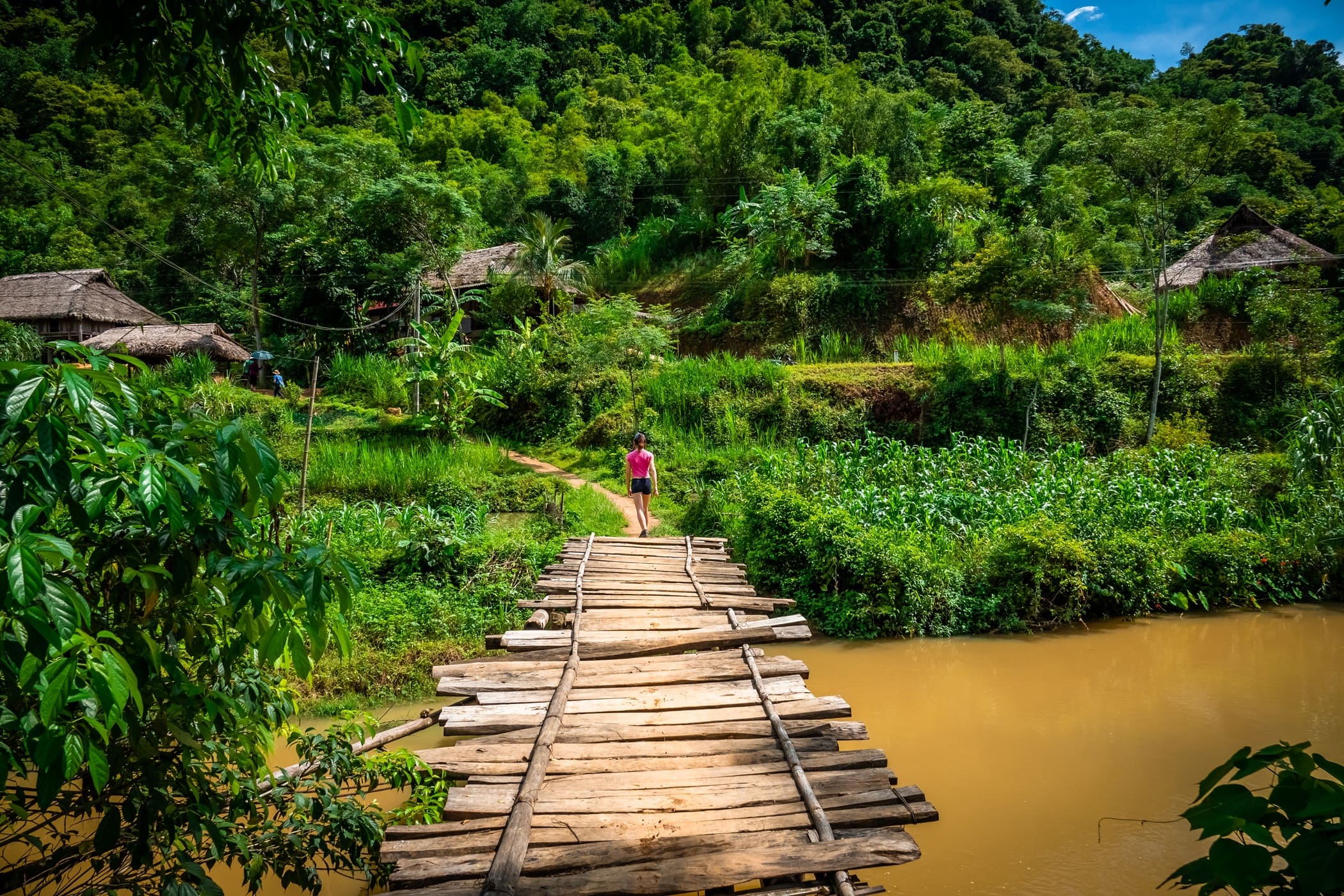
Young woman hiking on a wooden bridge in Pu Luong, rural area close to Mai Chau, Vietnam.
Route 3: Hiking to the Peak of Pu Luong
Okay, adrenaline junkies this one’s for you. The “Everest” of Pu Luong sits at 1700 meters, which sounds innocent until you’re four hours in and muttering motivational quotes to yourself (actual quote: “Breathe in… don’t whine out”). Most folks launch from Don Village at dawn or, for the “full send” crowd, at 3 AM headlamp blazing.
I’ll keep it real: the hike is relentless. You’ll slog across terraced rice fields so pretty it’s distracting, wade through dripping jungles, and scramble up rocky slopes where even the squirrels might judge you. Bring trekking poles if you value your knees the path is steep and root tangled.
But here’s that moment everyone talks about: cresting the true summit. Suddenly, you’re above the clouds, staring down on the wave of mist soaked mountains and patchwork fields. Locals say the sunrise up here inspired half the region’s folk songs. (No pressure, but it really IS magical.)
Life hack: A thermos of hot tea and some Oreos at the top turns you into everyone’s best friend. Don’t forget a windbreaker even Vietnam packs a mean summit chill.
Oh, Did You Know?
– Guided treks run from $35–$60, including meals and a cozy homestay bed.
– Packing tip: Wind oil yes, the minty stuff wards off both muscle soreness AND those hangers on forest squirrels (well, sort of…).
– Locals love when trekkers try a few words in Thai or Muong, even if your accent is “unique.” Instant smiles.
Whether you’re here for bragging rights, life changing scenery, or just to test your mettle, Pu Luong’s advanced trekking gives you ALL the stories (and new muscles) you never knew you wanted. Seriously, toss a question in the comments section if you want packing lists, off the record trail eats, or a pep talk your next adventure is calling.
Trekking Tours in Pu Luong Nature Reserve by DCT Responsible Travel
Okay, real talk If you’re searching for a Pu Luong nature reserve trekking experience that’s big on adventure and low on headache, you might’ve landed in the right spot. This company, DCT Responsible Travel, claims to have cracked the code on exploring Pu Luong without missing out on all the flavor, culture, and those jaw dropping rice terrace selfies. But is their version of hiking through this part of Vietnam just another “insert crowd here” tour, or does it actually serve up an authentic slice of local life? Let’s dig in …
What’s Actually Included? Spoiler: More Than Just Walking in Circles
Here’s the skinny on typical DCT Responsible Travel packages (and before you ask, yes, you can go full “choose your own adventure” and tweak some details):
- Guided Trekking: You get legit, local guides who don’t just recite the names of trees they tell you which leaves are good for bug bites, and, occasionally, which ones might cause ahem… bathroom emergencies. (Don’t ask how I know that.)
- Homegrown Hospitality: Overnights? Expect stilt houses deep in the Thai and Muong villages think: bamboo floors, fresh air, family dinners, and someone’s grandma insisting you try her sticky rice wine. It’s wholesome, unexpected, and four star if you grade hospitality on heart.
- Meals & Snacks: It’s not all instant noodles. In fact, expect wild greens, hearty stews, and whatever fruit is in season sometimes eaten off a banana leaf, sometimes right off the tree.
- Cultural Experiences: Want to join a rice harvest or dance the traditional sạp bamboo sticks? You’re in luck. Some treks match up with village festivals or market days, so you can bust out those TikTok moves and proudly embarrass yourself. Trust me, the locals will love it. Or at least find it hysterical.
- Gear & Support: You’ll get porters for heavy bags. No sherpas, but close. Bring your own boots, though trust me, I learned the hard way that “mountain proof” flip flops are NOT a thing.
Insider Lowdown (Anecdote Time)
On one trip, my guide stopped the group in the middle of a misty bamboo forest just so we could listen to dawn birdsong. Fifteen zen minutes later, we were being taught the correct way to chew sugarcane (hint: chew, don’t swallow). It was a moment of unexpected calm in the middle of mud and sweat. Pure Pu Luong. Zero filter needed.
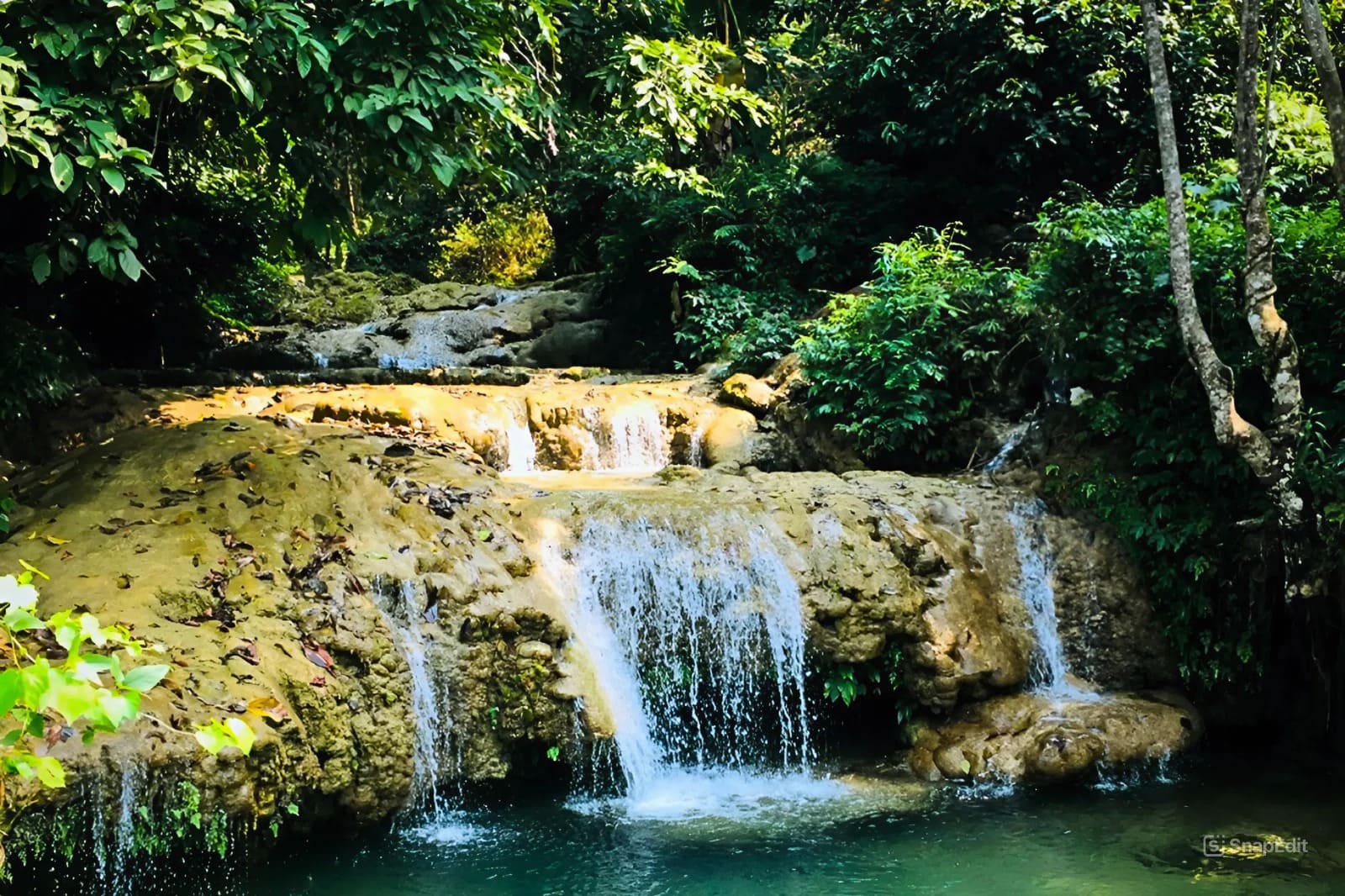
Hieu Waterfall, Pu Luong Nature Reserve
Tour Styles, Trails, & Talents (aka Will I Survive?)
Worried about your fitness? So was I… right up until a spry 70 year old local lady outpaced my latest attempt at an REI power walk. The truth: DCT splits hikes by ability level. Here’s a cheat sheet:
|
Trek Type |
Description |
Perfect For… |
|
Village Walks |
2–5km, flat, stops for tea & gossip |
All ages & selfie lovers |
|
Rice Terrace Loops |
5–12km, moderate up/downs, scenic overload |
Casual hikers & foodies |
|
Mountain Climbs |
10km+, rocky, ends at Pu Luong Peak (1,700m elevation) |
Adventure junkies & strong legs |
Callout: Even “easy” treks turn muddy when the rains hit July, August. (You’ll bond with your group while scraping clay off your boots… or your pride.)
What Sets DCT Apart? (Besides Unlimited Rice Wine)
- Small Groups: Think “family dinner” not “school field trip.”
- Responsible Footprint: Part of your fee supports village schools, eco projects, and they discourage single use plastics. One trip, the guide even handed out reusable bamboo straws which almost made me forgive him for the spicy lunchtime chili.
- Insider Access: Most of the hiking trails aren’t splashed all over Instagram yet. DCT’s guides are plugged into hidden waterfalls, private homes, and trails where you’ll meet more water buffalo than tourists.
Watch Outs & Pro Tips (Because Someone Has To Say It)
- Weather Roulette: If you’re a fan of dry socks, aim for September–November. Monsoon = mudslide mayhem. Pack at least two changes of socks… unless you’re cool with “rice paddy foot.”
- Budget Wisely: Typical tours run $70–$120/day (2024 rates) that’s with food, guides, and basic accommodations. Fancy linens cost extra (try the local market for deals).
- Cultural Nuances: Brush up on bowing, use both hands to accept gifts, and don’t laugh if you see a chicken wearing a colorful apron. It’s probably in honor of a festival.
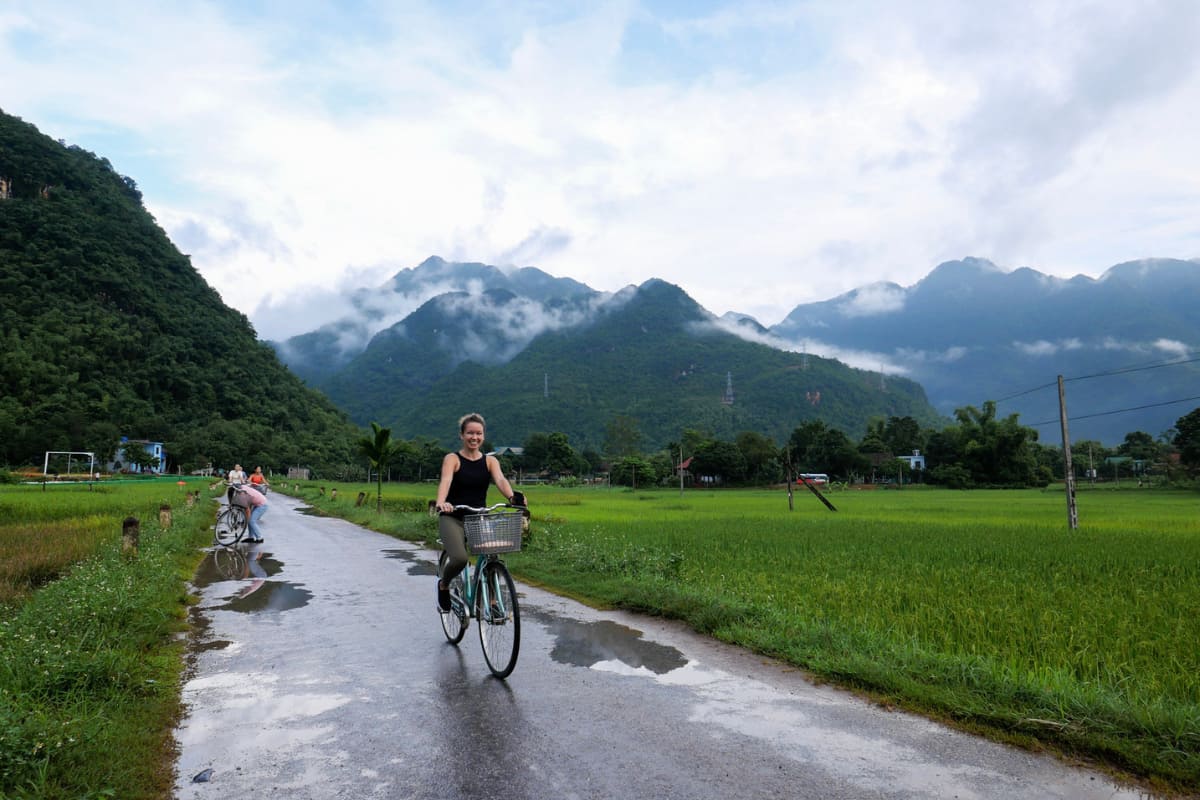
Cycling, Pu Luong Nature Reserve
“But Is It Worth It?” (Cue: Relatable Reflection)
If you want to snap a quick Insta and bounce maybe pick a different spot (hello, Sapa). But if the thought of watching buffalos stroll through morning mist while you dodge wayward ducks on the trail sounds appealing? Yeah, this could become your new obsession. Don’t skip out on the early morning market scene at Pho Doan it’s part fashion show, part farmers’ market, all local flavor.
Oh, and if you’re a nervous first timer: relax. You don’t need to be Bear Grylls. The terrain is honest but not cruel, the guides are patient, and if you get winded, someone will probably offer you a homemade energy snack (“sticky rice ball” nature’s original Clif Bar).
Want to swap trek stories or have a suggestion for the best rain poncho on a budget? Drop a comment below let’s swap mud tales.
Best Time to Trek in Pu Luong
So you want to know the secrets to timing your epic Pu Luong adventure? Pull up a chair this isn’t just about dry facts or weather charts. This is real talk from one hiker to another (and trust me, after a couple of soggy socks and one regrettable leech encounter, I’ve got stories…).
Let’s break it down:
What’s the “Goldilocks” Season?
If you like me dream of lush rice terraces and cool mountain air without the mudslide o rama, you’ll want to aim for October to April. That’s the cool, dry season. Imagine: crisp mornings, clear blue skies, and trails that don’t try to eat your shoes. Smell that? That’s adventure and possibly a whiff of grilled sticky rice from a local market stall.
Peak rice field drama hits twice a year: May to June and September to October. Locals call these the “golden seasons.” Everything glows (seriously, bring sunglasses), and if your Instagram is looking too beige lately, this is your chance to fix it.
Funny story my last September trip turned into an accidental photography contest with a group of Vietnamese aunties. Spoiler alert: I lost, but my camera roll won big. The colors are just out of this world…
Table: Pu Luong Trekking Seasons at a Glance
|
Season |
Weather |
Scenery |
Trekking Difficulty |
What’s Special |
|
May–June |
Warm, some rain |
Green terraces |
Moderate, muddy paths |
Rice planting, water wheels |
|
Sep–Oct |
Warm, showers |
Golden terraces |
Higher traffic, slippery |
Fresh harvest, vivid views |
|
Oct–Apr (Prime) |
Cool, dry |
Misty, lush, clear |
Easier, less leeches |
Ideal for summit seekers |
|
Jul–Aug |
Hot, humid |
Deep green, waterfalls |
Start early, rest midday |
Crowds drop, lush escape |
Real Talk: Should You Fear the Rain?
Picture this: you’re halfway up Mount Pu Luong, mist curling through the bamboo forest. It’s dramatic and slightly spooky…until a surprise storm turns your path into what can only be described as a slip n slide for adults. Fun? Depends on your definition.
My verdict: If you’re cool with a little mud and love that just rained scent, don’t rule out late spring or summer. It is the price for those vibrant rice paddy shots (and, hey, mud makes for the ultimate spa treatment, right?). If you’re not a fan of leeches or slippery stones, though, dry season is your best buddy.
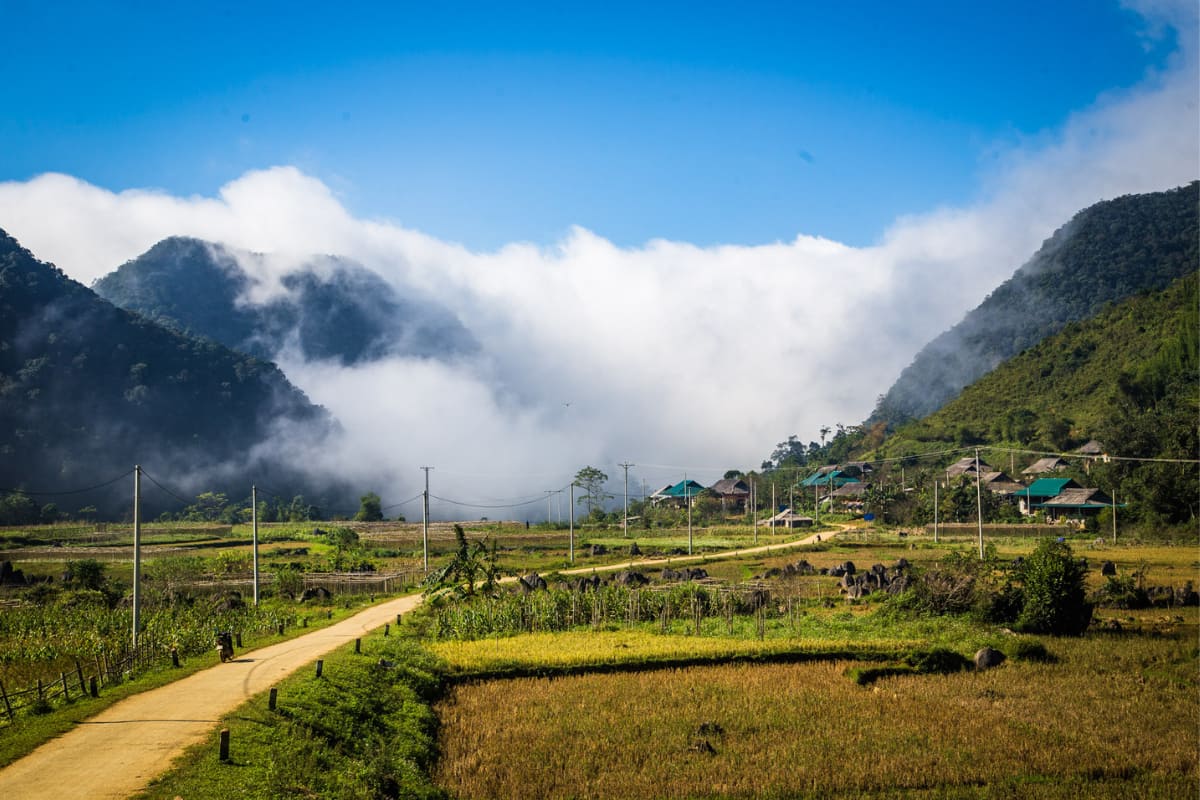
Best Time to trek in Pu Luong
Local Insider Tip
Locals swear by the mid autumn window, right when rice turns gold and the air is just cold enough that your hiking boots finally get to live their best life. I once joined a rice harvest in Ban Hieu Village ending the trek with sticky hands, full belly, and a crash course in Vietnamese laughter. Highly recommended.
What If You Only Have Summer Off?
Yeah, it gets steamy. Pro hack: start trekking at sunrise (I know, alarms are evil, but trust me on this one). Wrap up by noon, then cool off in a homestay pool, sipping fresh sugarcane juice. You’ll dodge the heat, and people in the villages might just ask about your SPF secrets.
Or if you’re an early riser, you might just catch the legendary morning mist that wraps Pu Luong like an Instagram filter set to moodiest.
Wait Is There Ever a Bad Time?
Short answer? Not really unless you’re actively avoiding beautiful scenery (in which case, I have questions). Each season brings its own flavor, so just match your adventure level and expectations.
Side quest: Ask your guide about local legends. On a foggy winter morning, the stories hit different.
Where to Stay in Pu Luong Nature Reserve
Imagine waking up as the sun rises over misty rice terraces… Roosters crow, distant waterfalls murmur, and you realize no honking horns, no packs of selfie sticks. (Not a single karaoke bar blaring Despacito at 5 a.m.) This is the real adventure, friend. So where do you sleep after a day of trekking and hiking through Pu Luong’s lush landscapes? Let’s get personal and practical.
Homestays: For the Story Collectors
Let’s be honest nothing screams “authentic ecotourism” quite like bedding down in a stilt house, listening to frogs serenade you under a canopy of stars. If you want to feel the pulse of rural Vietnam, this is for you.
Hand on heart, my first night at a mountainside homestay in Kho Muong Village was an adventure in itself. You’re tucked under a mosquito net on a mattress just steps from open air balconies… Wind rustling the thatch, your host quietly humming while prepping breakfast rice (way before you even think about opening your eyes).
Typical features include:
- Stilted wooden homes with bamboo accents and thatched roofs think “eco chic” meets “Grandma’s farm.”
- Shared bathrooms (sometimes with killer valley views who knew brushing your teeth could be so scenic?!)
- Home cooked meals… and yes, if you’re lucky, a shot of local rice wine to toast your 14 blisters.
Price vibes? Budget friendly even backpackers eating instant noodles will feel flush. Expect homestay rates from about 100,000 VND per night (roughly $4 USD). (Want a comparison? That’s less than your Grab ride from Hanoi airport.)
Real life hack: Book ahead during Vietnamese holidays. I once got stranded and ended up learning to play a bamboo flute (badly) while waiting for a spare mattress. Cozy, but not for everyone.
Eco Resorts & Retreats: For Creature Comfort Seekers
Craving a hot shower after a long, muddy hike? Maybe a dip in an infinity pool with panoramic views that even your cousin’s drone footage couldn’t top? Pu Luong’s “new wave” is all about eco luxury without the pretension. Think of it as camping if camping served up cocktails and Instagrammable breakfasts.
Options like Pu Luong Retreat, Eco Garden, and Boutique Garden offer the sweet spot between wilderness and Wi Fi.
|
Resort/Retailer |
Room Type |
Typical Price (VND-USD/night) |
Best for |
|
Pu Luong Retreat |
Deluxe/Pool Bungalow |
1,000,000 ($39) |
Infinity pools and sunset vibes |
|
Pu Luong Eco Garden |
Eco Room |
500,000 – 800,000 ($20-31) |
Mid range comfort with rustic charm |
|
Boutique Homestay |
Terrace View Suite |
300,000 – 600,000 ($12-23) |
Budget conscious travelers, solo adventurers |
Word to the wise: Some “eco resorts” are actually homestays that have upped their towel game. Always ask about what’s included… Will there be hot water, working fans, or Wi Fi strong enough to upload your embarrassing river crossing videos?
Personal moment: My best trip involved a cozy resort room overlooking golden rice fields in September. I had sore legs, mud splattered shoes, and a sense of accomplishment so strong it tasted better than the cold Saigon beer waiting on my terrace.
What Should Beginners Know (or Laugh At)?
Worried about language barriers? Spoiler: Google Translate never asks you why you’re putting chili in your morning pho. Don’t stress hosts are usually thrilled to have trekkers visit, and stories get even better through enthusiastic charades.
If you’re shy, group up! Most travelers share communal spaces, so don’t be surprised if you make a few new friends over a dinner of sticky rice and mountain greens.
Handy checklist for first timers:
- Bring a headlamp. Some guesthouses treat “nightlight” as optional.
- Pack earplugs if you’re a light sleeper. Roosters? Early risers.
- Always have a backup plan. Rainstorms happen fast, and that “short walk” may turn into a squelchy epic.
- Double check room details shared bathrooms, hot water, private balcony? Sometimes the “view” is just a goat. (Still cute.)
Choosing What Fits Your Adventure
Getting torn between glamping and going full rustic? That’s normal. My rule: If you want to hear village gossip and learn how to pound sticky rice, pick a homestay. Want to rest those legs and snap infinity pool shots? Head for a mountain lodge.
And if you have a favorite hiking sock, bring TWO pairs. Trust me.
PS: Booking.com is where many adventurers start searching, but chatting with your trekking guide or new friends on the trail can reveal hidden gems sometimes the best bed is a local’s spare room you just trekked past after getting lost for two hours (true story).
Ready to claim your Pu Luong basecamp and get out there? You’ll earn stories and maybe a new appreciation for simple joys, like a homemade cup of green tea at sunrise. Have any “unique homestay adventures” or wild accommodation stories? Share below! Your future self (and fellow trekkers) will thank you.
Dining and Refreshments in Pu Luong Nature Reserve
Let’s be honest … After a day of trekking (or is it “floating sweatily uphill while swatting mosquitoes like a ninja?”), the thought of dinner is almost intoxicating. Here’s where Pu Luong Nature Reserve flexes its very tasty muscles… and a bit of local magic.
Ever found yourself halfway up a rice terrace, stomach rumbling, daydreaming about something anything other than stale granola bars? Yeah, I’ve been there too. The good news: Pu Luong actually delivers on the post hike feast. I’ll never forget collapsing in the common room of my homestay, mud on my socks, only to be greeted with a steaming platter of sticky rice and sautéed greens so vibrant you’d swear they’d been harvested by a ninja gardener that same hour. Spoiler: they had.
Homestay Meals – Local Love on a Plate
You can absolutely count on most homestays to serve up some home cooked goodness. The food’s often simple, farm to table fresh, and… well, you might find your brain momentarily blanking on the English word for “vegetable” after your third bite because, wow, this tastes nothing like supermarket spinach. Here’s what’s usually up for grabs:
- Family Style Feast: Bowls of steaming rice, wild greens, fried tofu, and local specialties like braised pork belly or free range chicken sometimes with that tangy local passion fruit sauce that deserves its own fan club (where do I sign up?). My personal rule: always say yes to seconds. You do NOT want to miss out.
- Table Camaraderie: Meals are typically shared with other guests and the family, so be ready to swap trail tales and giggles over shots of sticky rice wine let’s just say, it’s an acquired taste (don’t make a face, someone’s grandma is watching).
And for the picky eaters or vegetarians: no worries. Nearly every homestay will whip up veg friendly eats if you give them a heads up. During my last trip, I watched a Dutch trekker marvel at a tofu and pumpkin hotpot that will likely haunt all her future meal dreams.
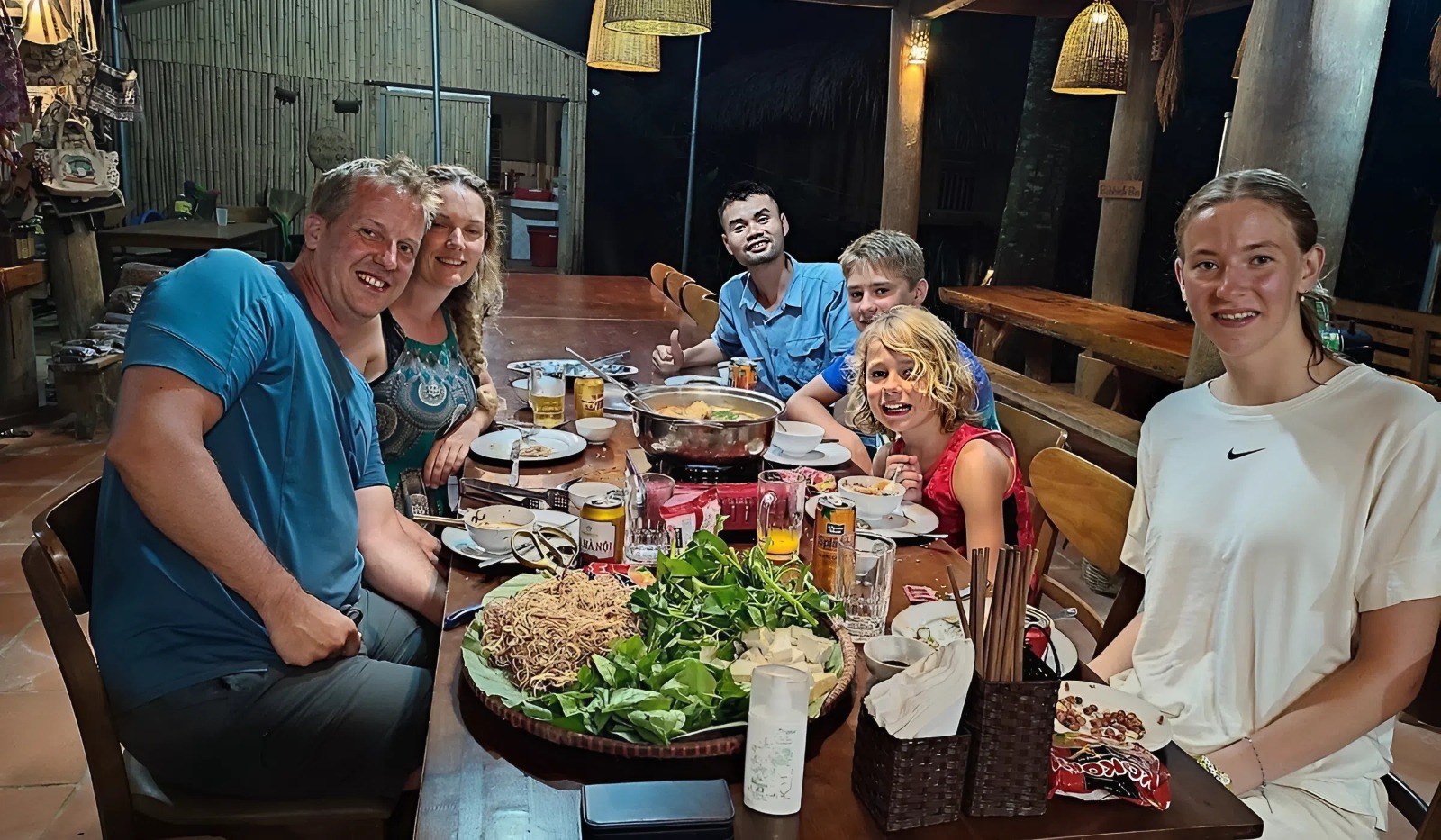
Enjoy dinner at homestay, Pu Luong Nature Reserve
Restaurants With a View… and Surprising Menus
If you’re worried homestay food is too “rustic,” Pu Luong’s handful of restaurants are here to save the day. Let’s talk options including a pizza that’s oddly legit for the middle of Vietnam.
- Don Village “Stilt House” Restaurant: Picture this sitting high up on bamboo stilts, slurping noodle soup, eyes drinking in the valley with zero phone signal to distract you. Their duck dishes are outstanding. Try the braised pork belly and thank me later.
- Unexpected Western Fixes: Maybe you’re cut from the “pizza after trekking” cloth (respect). Places like Don Village offer surprisingly good pies and chips. I once argued with a friend if “mountain mozzarella” was a real thing… until he licked his plate.
- Veggie Adventure: Vegetable curries loaded with squash and potatoes appear on several menus. It’s a small miracle after a long hike, but it brings a smile even if your legs forgot how to move.
Check the schedule:
|
Place |
Food Highlights |
Hours |
Insider Note |
|
Don Village Stilt Restaurant |
Duck, braised pork, pizza, noodle soup |
7am–11pm |
Ask for the passion fruit chicken |
|
Viewpoint Café |
Curries, cold drinks, coffee, stunning view |
6am–10pm |
Go at sunset photos, not regrets |
|
Homestay Communal Table |
Set menu: rice, tofu, wild greens, pork |
Varies |
Share a table stories and rice wine alike |
The Quirky Truths Bugs, Culture, and Mystical Rice Wine
Fair warning to anyone in the “I need a spotless tablecloth” camp: Pu Luong dining is outdoorsy, a little wild, and that is… exactly what you want on a true ecotourism adventure. Expect the odd beetle at dinner (he prefers cucumber, you’re safe) and bring bug spray if, like me, you attract mosquitoes at ten meters. Side note: local legends say those with “sweet blood” get bit twice as much. I’m apparently dessert.
Oh, and the rice wine? Let’s say the first shot burns, the second’s smoother, and by the third you’re plotting a dance off with your host family. There’s often music, so why not?
Hydration & Hiking Don’t Get Caught Dry
After trekking or hiking through all that scenery, don’t skimp on liquids bottled water’s readily sold at homestays and small shops in every village. Top pick: the lemon iced tea at the viewpoint café. Sit with a glass, kick your boots off, and just stare at the terraced hills until you can once again feel your toes. (Good luck standing up again pure bliss.)
Quick tip for beginners: Not everything is labeled in English. Don’t panic: a smile and a point does wonders in Vietnam. Worst case, the friendly owner will just pile your plate high with whatever’s fresh that day and chances are, you’ll love it.
You’ll leave with a full belly, a new appreciation for homemade food, and if you’re anything like me a craving for eggplant grilled over a smoky wood fire straight from the rice paddy’s edge. Pu Luong might not do fine dining, but it absolutely nails real world flavor. Why else do you think I trek back every year? You’re up next.
Tips and FAQs for a Successful Pu Luong Trekking Adventure
Alright, you’re thinking about pu luong nature reserve trekking cue the excitement…and maybe a few nerves. Trust me, even if your last “trek” was a power walk through the local mall (extra points if you dodged a rogue stroller), Pu Luong is totally doable with the right mindset and prep. Feeling lost in the planning? Let’s make this easier than finding pho in Hanoi.
Packing Like a Pro (Or at Least Someone Who Kinda Has Their Life Together)
Let’s have a real talk about what should be in your pack skip the “survival guide” overkill and go with what actually works up in those wild hills. Forgetting sunscreen or decent socks? Been there. You do NOT want “Vietnam souvenir: epic sunburn” on your trip playlist.
Must Have Essentials for Pu Luong (from a serial overpacker to you):
- Serious sneakers or grippy hiking shoes: Don’t be the person sliding down a muddy path in flip flops. Even running shoes with solid tread beat worn out trainers.
- Water resistant layers: Monsoon clouds love surprise cameos. I once wore a banana yellow poncho from VinMart. Not my chicest look, but hey, I was dry.
- Snacks you’re not yourself when you’re hungry: Think Snickers, local pastries, or boxed milk (“sữa tươi” from Vinamilk trust me).
- Cash in VND: Card machines in rural Vietnam? About as rare as a yeti in hiking shorts.
- Med kit (band aids, ibuprofen, Imodium): Stomach bug on day two? Let’s avoid THAT plot twist.
- Sunscreen & insect spray: Mosquitoes are extra in the rice paddies.
- Sunglasses & a hat: Keep that blazing sun out of your face (and your selfies glare free).
Sidebar confession:
On my first trek here, I forgot insect spray. Let’s just say local mosquitoes gave me a warm Vietnamese welcome. Don’t repeat my rookie move.
When’s the Best Time? Don’t Let Weather Play You
Picture this: You’re hiking past golden rice terraces, the air is crisp, locals wave as you walk by, and you don’t feel like you’re melting into your own shirt. That’s high season in Pu Luong, friend.
Prime Time:
- May to June, September to October: “Golden” rice fields. Instagram gold. The weather? Warm, breezy, but not sauna level.
- October to April: Less rain, cooler mornings and evenings bring a light jacket.
- Hot Tip: If you’re sweating buckets in July, start EARLY like 7 AM early. By lunch, reward yourself with a pool dip or a coconut juice in a local homestay.
Out of Season Real Talk:
Been here in August? Let’s just say your rain poncho will hit MVP status. Always scope out the weather forecast weather apps aren’t perfect, but they’re less judgmental than asking a local if it’s going to rain for the tenth time.
Guided or Solo? Pick Your Own Adventure
Here’s where you get to choose your own trek tale:
- Guided Tours: Perfect for first timers, families, or anyone who wants to deep dive into culture and skip worrying if “left at the big tree” means THIS tree or…that one. Local guides get you to cool spots like hidden waterfalls in Hieu Village plus, they’ll drop legends and folklore sprinkled through your walk. Some even come bundled with meals or home cooked snacks (I still crave auntie’s sticky rice cake).
- DIY Trekking: Feeling brave? You’ll need: a cell phone with working GPS, a good offline map app (Maps.me is my “not lost yet!” MVP), and a willingness to ask for help in broken Vietnamese. Pro tip almost everyone will try to help, even if you both resort to interpretive dance.
Quick FAQ Pep Talk
What should you expect on the trail?
You’ll pass bamboo forests, centuries old stilt houses, and villages with names you’ll try (and fail) to pronounce. The adventure is real…so are the cows blocking the path.
Is it beginner friendly?
Yep! Lots of trails are more “epic stroll” than “mountaineer challenge.” If you can handle a few stairs or a hilly park at home, you’re golden.
Any cultural quirks I should know?
Take your shoes off before entering homes. Learn a few words “xin chào” (hello) goes a LONG way. If invited to a rice wine toast at dinner, accept politely just maybe not all ten rounds.
Is technology useless out here?
Wi Fi is patchy in bamboo groves (shocking, I know). Download maps, get your translation app ready, and embrace the digital detox.
Comparison Table Getting the Most from Your Pu Luong Adventure
|
Prep Level |
DIY Trek (Solo) |
Guided Tour |
|
Cost |
$25 (local homestay, snacks) |
$50–$100+ (all in, meals incl.) |
|
Route Flexibility |
Customizable |
Set, but curated |
|
Culture Immersion |
High if you interact |
Super High guided stories |
|
Language Barrier |
Challenge |
Eased by guide |
|
Max Horsepower Needed |
Decent fitness (carry own pack) |
Light most logistics sorted |
Last Minute Sage Advice (You Got This!)
- Hydrate. Seriously, bring more water than you think.
- Greet locals with a smile. “Xin chào” = doors open, hearts warm.
- Don’t stress if you get lost a kind villager (or kid on a bicycle) will likely save the day.
So whether you’re trekking with new pals or flying solo like a Vietnamese eagle, Pu Luong is waiting. It’s not about smashing mileage records it’s about soaking in the scenery, nabbing a bowl of noodles at the next village, and maybe laughing at the inevitable minor mishaps (those make the best stories anyway).
Got questions, hidden trail gems, or your own epic mudslide story? Drop them in the comments I’m all ears (and still brushing the Pu Luong dust off my boots).
Pu Luong – The Perfect Nature Retreat Near Hanoi
Ever wish you could hit pause on the chaos of city life? Welcome to Pu Luong where Vietnam’s wild heart beats loud and clear and time seems to stretch with every step you take on those sweeping rice terraces. Seriously, if you’re craving a real escape, this is the sort of nature reserve that might just have your fingerprints on its bamboo railings by next weekend.
Let’s get going: You wake up in Hanoi, caffeine barely kicking in, and you realize Pu Luong is only about 160 kilometers away. Not too far, right? It’s like driving from Manhattan to the Hamptons but instead of bagels and beach houses, you get misty valleys, secret waterfalls, and… yes, the gentle clatter of buffalo wandering their own well worn footpaths. Climbing up to 1,700 meters at its highest point, Pu Luong’s breezy mountain air can make you forget what humidity even feels like. (Imagine, not sweating through your shirt by 10am. Miracles do happen.)
What really makes pu luong nature reserve trekking pop? Oh, just the sense that you’re starring in your very own adventure documentary. Picture this lush, green rice terraces stacked like a giant’s staircase, their edges melting into dense bamboo forest and tangled jungle straight out of a Miyazaki film. If you’ve ever wanted your selfies to look epic, this is the place. Just don’t trip while lining up that perfect “I conquered the wilds” shot the only thing less graceful than my last attempt was a water buffalo trying to roller skate. (True story. Not proud.)
You’re not climbing Everest here, and that’s the beauty. Whether your idea of fun is “let’s crush a 15 kilometer trail before breakfast” or “let’s stroll gently, make friends with a grandma weaving baskets, and eat sticky rice until we collapse” Pu Luong’s got you covered. There are friendly, guide led tours that feel like casual walks, and gnarlier trails pushing your legs (and sense of direction) to their limits. One time, I tried the Bang Village to Kho Muong trek and managed to get lost for an hour. Turns out the only “wild animal” I encountered was an overly enthusiastic chicken. Either way, your stories will be legendary.
Miss the tourist mobs? Pu Luong laughs quietly in the face of crowds. Unlike Sapa or Ha Long Bay, it’s a rare haven for those who appreciate stillness. More birdsong than bus horns, more laughter from kids in villages than selfie stick chaos. Grab a homestay in a traditional stilt house, and you’re not just eating dinner you’re swapping dumb puns with your hosts, sampling bamboo tube rice, and maybe even getting roped into a local dance (pro tip: embrace the awkward moves).
Hungry? You will be. Lucky for you, local families love sharing their smoky barbecued pork, crispy wild greens, and brothy Goi Ca fish salad. Ask for seconds. No one judges here. You will probably drink homemade rice wine whether you expect to or not. It tastes like something between sake and pure courage. Hydration is important. So is laughter.
Worried about gear? You don’t need to drop a fortune at Patagonia. Solid sneakers, a rain shell, and that adventurous spirit that’s your starter pack. Local markets have what you forgot. And if you really want to win hearts, bring a few small candies or postcards from home. The kids love connecting and showing off their English: “Hello. What’s your name? Where you from?” The first time it happened, I nearly cried (and then tripped over a basket of sticky rice cakes classic me).
So… curious what the vibe is? Imagine waking to birds, trekking through clouds, and ending your day cooling your feet in a stream while chatting with people whose lives seem woven from older, slower cloth. You breathe out. Pu Luong breathes in. Stress has literally left the group chat.
Thinking of dipping your toe into hiking or even a bigger trekking adventure but feeling iffy about your trail cred? Start here. Pu Luong is gentle enough for newcomers and rewarding enough for seasoned adventure buffs. And let’s be honest sometimes the slow path (with a cold beer at sunset) is the most satisfying trail of all.
If you want to escape the loud, fast world for a while, and maybe recenter your inner compass (or just have an Instagram feed that makes your friends jealous), Pu Luong’s scenery and spirit have your name written all over them. What are you waiting for? Backpack, sneakers, questionable hat let’s go. avoid afternoon showers.



